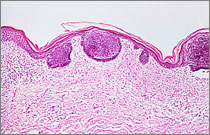Mesothelioma
¹ per 100,000 persons, age-standardised according to the old European standard population
* until 1.12.2020
** calculated using the period method for 2019 / 2020
| 2022 | ||
|---|---|---|
¹ per 100,000 persons, age-standardised according to the old European standard population * until 1.12.2020 ** calculated using the period method for 2019 / 2020 | ||
| Women | Men | |
| Incidence | 240 | 1.003 |
| Age-standardised incidence rate¹ | 0.3 | 1.3 |
| Deaths 2023 | 238 | 907 |
| Age-standardised incidence rate¹ | 0.3 | 1.1 |
| 5-year prevalence* | 500 | 1,500 |
| 10-year prevalence* | 800 | 1,700 |
| Relative 5-year survival rate** | 14 % | 8 % |
| Relative 10-year survival rate** | 10 % | 5 % |
Mesothelioma is a rare soft tissue tumour that occurs predominantly in men of advanced age. The most frequent localisation is the pleura, with tumours arising more rarely in the peritoneum. In 2020, about 1,190 men and 290 women were diagnosed with mesothelioma in Germany.
Comparatively high incidence rates are still found in the northwest of Germany at (former) shipbuilding sites, for example in the federal state of Bremen and neighbouring regions, and to some extent also at steel industry sites, such as in the Ruhr area. Some regions near former asbestos product manufacturing sites are also affected.

![]() Age-standardised incidence rates of malignant mesotheliomas in men by district, ICD-10 C45, Germany 2010–2014, per 100,000 (old European standard population)
Age-standardised incidence rates of malignant mesotheliomas in men by district, ICD-10 C45, Germany 2010–2014, per 100,000 (old European standard population)
With relative 5-year survival rates of 8 percent in men and 14 percent in women, mesothelioma is among the cancer types with the least unfavourable prognoses.
Asbestos fibres are the most important risk factor
Inhalation of asbestos fibres is the main cause of most of newly diagnosed mesotheliomas today. Although the processing of asbestos was generally banned in Germany in 1993 and later in the entire EU, there is an average latency period of 30 to 50 years between onset of exposure and the manifestation of the disease. The occupational groups affected include, for example, metalworkers, welders, electricians, plumbers, roofers, bricklayers, construction workers, automotive technicians and tilers. About 1,000 new cases of mesothelioma were recognized by the employers’ liability insurance associations in 2016, and in 2018 there were almost 900. In cases where occupational exposure is not known, asbestos fibres can often be detected in X-rays or tissue samples, for example in women who have been exposed indirectly through contact with contaminated work clothing.
Weakly bound asbestos with high fibre content is particularly dangerous. In contrast, asbestos cement ("Eternit"), which can still be found in or on many buildings today, is considered largely harmless as long as it remains intact.
Other risk factors play a minor role. These include exposure to other fibres such as erionite or radiation therapy (of the chest or abdomen).
Date: 30.12.2024






